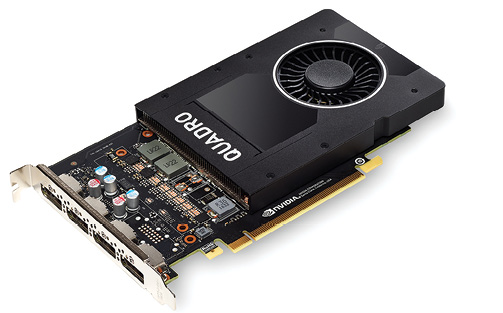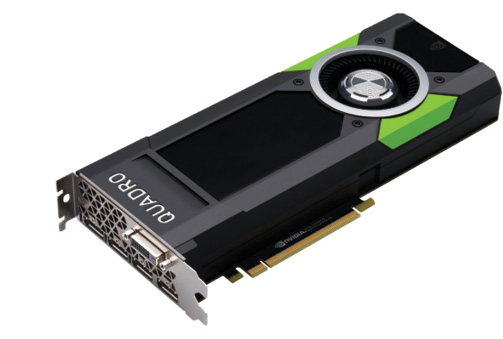NVIDIA Quadro Review: Super Computer Graphics

Fig. 1: The NVIDIA Quadro P2000 mid-range graphics board.
April 5, 2017
Last summer, at the SIGGRAPH conference, NVIDIA unveiled the first of a new series of graphics cards based on its Pascal GPU architecture (see “Graphics Power for Intense Work”). One of those boards, the NVIDIA Quadro P5000, arrived at our test lab in mid-December. In early February, the Santa Clara, CA-based company used the SOLIDWORKS World conference as the venue to announce several additional Pascal-based boards. Two of those boards, the Quadro P4000 and P2000, soon arrived at our offices as well.
Because it has been a few years since the last time we were able to get our hands on an entirely new family of NVIDIA professional workstation-class graphics cards, we quickly set about the task of testing these new boards.
Three New NVIDIA Boards Span Mid-Range to Ultra-High-End
The new NVIDIA Quadro P-series will eventually include a total of eight cards, ranging from the ultra-high-end P6000 and P5000 announced last summer, to the high-end P4000, the mid-range P2000 and P1000, and the entry-level P600 and P400. The company also launched Quadro GP100, a specialty high-performance computing board capable of 64-, 32- and 16-bit floating point calculations.
 Fig. 3: The ultra-high-end NVIDIA Quadro P5000 features 16GB of GDDR5X memory. Photos courtesy of NVIDIA.
Fig. 3: The ultra-high-end NVIDIA Quadro P5000 features 16GB of GDDR5X memory. Photos courtesy of NVIDIA.All eight new P-series boards are based on NVIDIA’s latest Pascal GPU architecture, built using a 16nm FinFET+ manufacturing process that allows the GPUs to include more transistors, operate at higher frequencies and deliver better performance per watt compared with previous-generation GPUs. The new boards incorporate more CUDA cores and larger framebuffers compared with their predecessors, allowing higher performance with larger datasets.
The NVIDIA Quadro P2000 is the company’s new mid-range solution, designed to handle medium-size CAD models. With an estimated street price of just $499, it effectively replaces the M2000. The new Quadro P2000 features 1024 CUDA parallel processing cores (compared with 768 in the M2000) and includes 5GB of GDDR5 memory, 1GB more than its predecessor. Its 160-bit interface is also wider than the 128-bit interface in the Maxwell-based M2000, enabling the new board to deliver a memory bandwidth of 140 GB/second (compared with 106 GB/s in the M2000). NVIDIA claims peak single-precision performance of up to 3.0 TFLOPs. The M2000 provides four DisplayPort 1.4 connectors enabling it to support up to four 4K monitors at 60Hz. With conversion adapters, these outputs can display any combination of DisplayPort, mini-DisplayPort, HDMI or DVI, allowing users the ability to connect to a wide range of displays. For example, the P2000 can support up to two 5K monitors at 60Hz or a single 8K projector.
The high-end NVIDIA Quadro P4000 is designed to handle large, complex CAD models, and with the optional new Quadro Sync II add-in card, to drive more monitors from a single system than ever before. When combined with a single Quadro Sync II card, up to four P4000 GPUs can be seamlessly synchronized to drive a 16-display power wall from a single system. The P4000 is positioned to replace last year’s M4000, yet with an estimated street price of $799, the P4000 matches the cost of its predecessor. Thanks to the new Pascal GPU, the P4000 consumes just 105 watts (compared with 120 watts for the M4000). Although the P4000 uses just a single PCIe x16 slot, its power consumption still requires an additional six-pin auxiliary power connector. The Quadro P4000 provides 1792 CUDA cores (compared with 1664 in the M4000) and includes 8GB of GDDR5 memory (the same as the M4000). Although both boards have a 256-bit memory interface, the P4000 increases the memory bandwidth to 243 GB/s (compared with 192 GB/s for the M4000), enabling the new board to deliver up to 5.3 TFLOPs of peak single-precision performance. The P4000 offers four DisplayPort 1.4 connectors and can support resolutions of 3840x2160 at 120Hz and 5120x2880 at 60Hz. Like its predecessor, the P4000 also supports stereo 3D using an optional three-pin connector on a separate bracket.
While both the P4000 and the NVIDIA Quadro P5000 are VR-ready, the more powerful P5000 can handle even larger, more complex models. With an initial estimated street price of $2,499, the P5000 is slightly more expensive than the previous generation M5000, but offers double the memory (16GB vs. 8GB). In addition, the P5000 and the even more powerful P6000, are the first enterprise-class graphics cards to implement error-correcting GDDR5X memory, facilitating operations at up to a 9 GB/s data rate. The P5000 also features 2560 CUDA cores (compared with 2048 in the M5000). Although the P5000 matches the 256-bit memory interface of the M5000, the newer board achieves a memory bandwidth of 288 GB/s (compared with 211 GB/s for the M5000). As a result, the P5000 achieves up to 8.9 TFLOPs of single-precision performance. All that extra muscle increases the maximum power consumption in the P5000 to 180 watts (compared with 150 watts for the M5000). As a result, this two-slot board requires an eight-pin auxiliary power connection. The NVIDIA Quadro P5000 provides four DisplayPort 1.2 connectors as well as a single DVI-I port. There is also a provision for an optional three-pin stereo connector on a separate bracket as well as framelock/genlock.
Testing the New NVIDIA Pascal-Based Boards
We tested all three new NVIDIA Quadro P-series boards using SPECviewperf version 12 (spec.org) in a BOXX workstation (boxx.com) equipped with an Intel Core i7-4790 quad-core CPU (overclocked to 4.5GHz) and 16 GB of memory, running Windows 10 Pro. We also retested a number of older NVIDIA Quadro boards in this same workstation as well as the latest GPU from AMD (see “A New Name and an New Look, page 33) to make direct performance comparisons.
Our results provide convincing proof of the performance improvement achieved by each succeeding generation of NVIDIA GPU. Each new board equaled or exceeded the performance of the next higher level of the previous generation. For example, the NVIDIA Quadro P4000 clearly outperformed the M5000.
Like all other NVIDIA Quadro boards, the Quadro P2000, P4000 and P5000 are fully certified with most engineering design applications, and all boards in the Quadro line use the same unified video driver and support Microsoft Windows 10, 8 and 7 (both 64- and 32-bit) as well as 32- and 64-bit versions of Linux. The boards are also backed by a three-year warranty. Once again NVIDIA has introduced new GPUs that deliver unprecedented levels of performance across its entire product line.
| NVIDIA Quadro P5000 NEW! | NVIDIA Quadro M5000 | NVIDIA Quadro P4000 NEW! | NVIDIA Quadro M4000 | NVIDIA Quadro P2000 NEW! | NVIDIA Quadro M2000 | |
| Estimated street price (at launch) | $2,500 | $2,000 | $799 | $799 | $499 | $499 |
| SPECIFICATIONS | ||||||
| Extra power required | Single 8-pin | Single 6-pin | Single 6-pin | Single 6-pin | No | No |
| Form factor (inches) | 4.38x10.50 | 4.38x10.50 | 4.38x9.50 | 4.38x9.50 | 4.38x6.6 | 4.38x6.6 |
| Slots used | 2 | 2 | 1 | 1 | 1 | 1 |
| Max Power (watts) | 180W | 150W | 105W | 120W | 75W | 75W |
| PCLe version | 3.0 | 3.0 | 3.0 | 3.0 | 3.0 | 3.0 |
| Processors | 2560 | 2048 | 1792 | 1664 | 1024 | 768 |
| Memory configuration | 16GB (GDDR5X) | 8GB (GDDR5) | 8GB (GDDR5) | 8GB (GDDR5) | 5GB (GDDR5) | 4GB (GDDR5) |
| Memory interface | 256-bit | 256-bit | 256-bit | 256-bit | 160-bit | 128-bit |
| Memory bandwidth | 288 GB/s | 173 GB/s | 243 GB/s | 192 GB/s | 140 GB/s | 106 GB/s |
| Number of DVI Dual Link Outputs | 1 | 1 | 0 | 0 | 0 | 0 |
| Number of Display Port Outputs | 4 DP | 4 DP | 4 DP | 4 DP | 4 DP | 4 DP |
| Stereo 3D Connector (3-pin) | Yes (2) | Yes (2) | Yes (2) | Yes (2) | No | No |
| Framelock/Genlock | Yes (1) | Yes (1) | Yes (1) | Yes (1) | No | No |
| Multi-GPU (SLI-NVIDIA) | Yes | Yes | Yes | Yes | No | No |
| OpenGL version | 4.5 | 4.5 | 4.5 | 4.5 | 4.5 | 4.5 |
| DirectX/Shader Model | 12/5.1 | 12/5.0 | 12/5.1 | 12/5.0 | 12/5.1 | 12/5.0 |
| Maximum Resolution Support | 7680x4320 (3) 2560x1600 (5) | 4096x2160 (4) 2560x1600 (5) 1920x1200 (6) 2048x1536 (7) | 7680x4320 (3) 5120x2880 (4) | 4096x2160 (4) 2048x1536 (7) | 7680x4320 (3) 5120x2880 (4) | 4096x2160 (4) |
Specifications for the new NVIDIA Quadro P-series graphics boards compared with the previous generation M-series boards.
1. Requires optional Quadro G-Sync or Quadro Sync card; 2. with optional expansion bracket; 3. resoution with DisplayPort 1.4 @ 30Hz; 4. resolution with DisplayPort 1.2 @ 60Hz; 5. resolution with DVI-I dual link @ 60Hz; 6. resolution with DVI-I single-link @ 60Hz; 7. Resolution VGA @ 85Hz.
More Info
Subscribe to our FREE magazine, FREE email newsletters or both!
About the Author
David Cohn is a consultant and technical writer based in Bellingham, WA, and has been benchmarking PCs since 1984. He is a Contributing Editor to Digital Engineering, the former senior content manager at 4D Technologies, and the author of more than a dozen books. Email at [email protected] or visit his website at www.dscohn.com.
Follow DE







